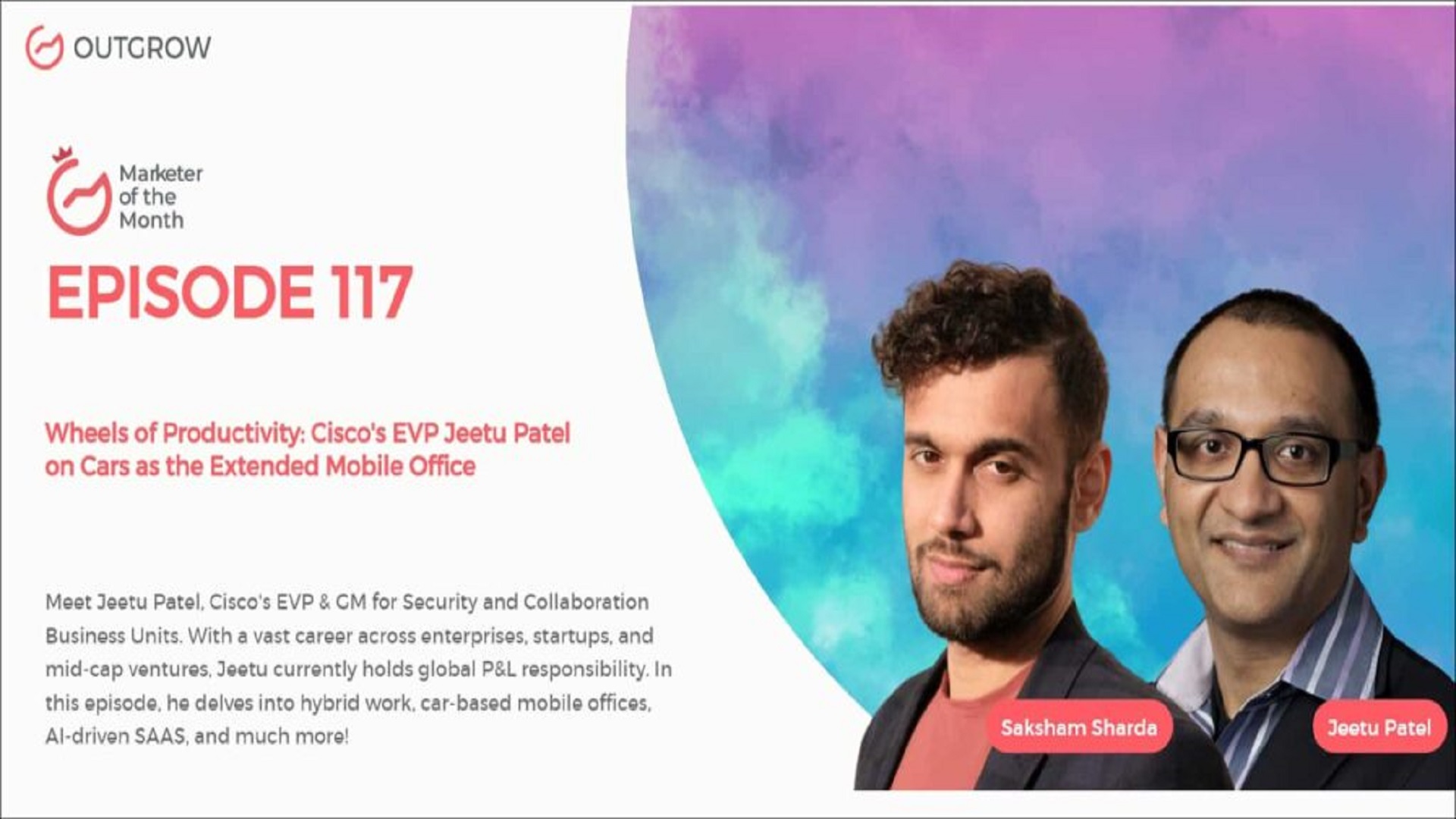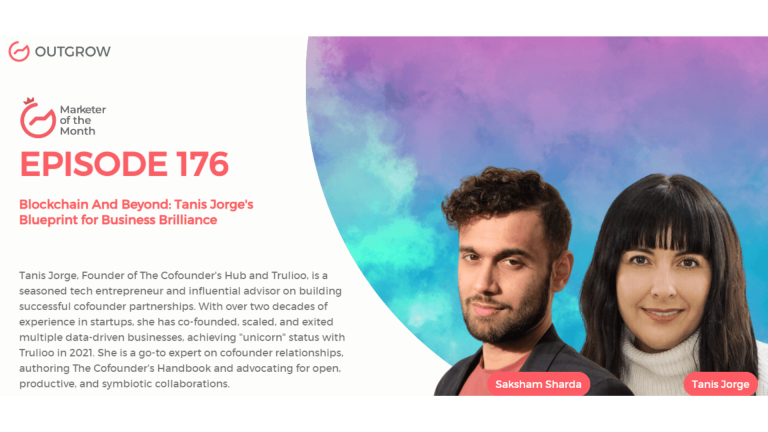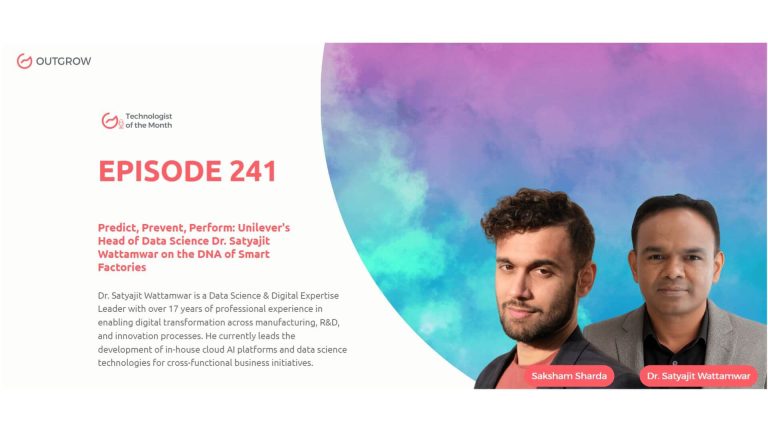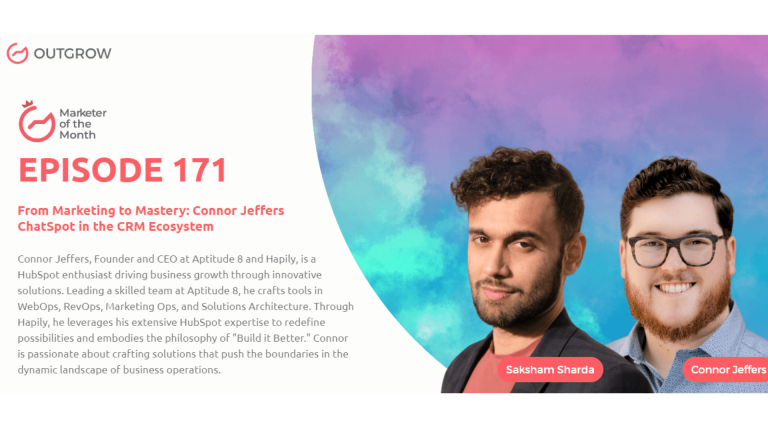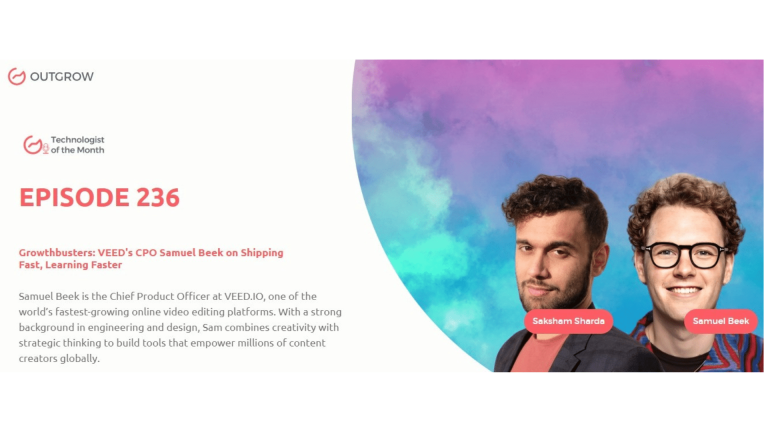EPISODE 117: Marketer of the Month Podcast with Jeetu Patel
Table of Contents
Hey there! Welcome to the Marketer Of The Month blog!
We recently interviewed Jeetu Patel for our monthly podcast – ‘Marketer of the Month’! We had some amazing insightful conversations with Jeetu and here’s what we discussed about-
1. Hybrid work: Inclusive communication and the future of work
2. Challenges for younger generations: How remote work hinders networking for the younger workforce
3. Role of automobiles: How cars extend the mobile office for remote productivity
4. Securing the modern enterprise: Adopting a common security cloud layer for flexibility in multiple cloud providers
5. Future of SAAS and AI: How AI integration revolutionizes SAAS user experiences
6. Webex innovation: Building an asynchronous video product
About our host:
Dr. Saksham Sharda is the Chief Information Officer at Outgrow.co. He specializes in data collection, analysis, filtering, and transfer by means of widgets and applets. Interactive, cultural, and trending widgets designed by him have been featured on TrendHunter, Alibaba, ProductHunt, New York Marketing Association, FactoryBerlin, Digimarcon Silicon Valley, and at The European Affiliate Summit.
About our guest:
Jeetu Patel is Cisco’s EVP & GM for Security and Collaboration Business Units. With a vast career across enterprises, startups, and mid-cap ventures, Jeetu currently holds global P&L responsibility. In this episode, he delves into hybrid work, car-based mobile offices, AI-driven SAAS, and much more!
Wheels of Productivity: Cisco’s EVP Jeetu Patel on Cars as the Extended Mobile Office
The Intro!
Saksham Sharda: Hi, everyone. Welcome to another episode of Outgrow’s Marketer of the Month. I’m your host, Dr. Saksham Sharda, and I’m the creative director at Outgrow. co. And for this month we are going to interview Jeetu Patel, who is Cisco’s EVP & GM for Security and Collaboration Business Units. Thanks for joining us, Jeetu.
Jeetu Patel: Great to be here. Thank you.
Don’t have time to read? No problem, just watch the Podcast!
Or you can just listen to it on Spotify!
The Rapid Fire Round!
Saksham Sharda: All right. So the first one is at what age do you want to retire?
Jeetu Patel: I hope I never retire.
Saksham Sharda: How long does it take you to get ready in the mornings?
Jeetu Patel: About 40 minutes.
Saksham Sharda: What’s your favorite mobile app?
Jeetu Patel: Spotify.
Saksham Sharda: The most embarrassing moment of your life.
Jeetu Patel: I forgot the topic of my speech when I was in the eighth grade to run for this class captain.
Saksham Sharda: Mountains or beaches?
Jeetu Patel: Mountains.
Saksham Sharda: What’s the most useful mobile feature you can’t live with?
Jeetu Patel: Comes from a mobile feature I can’t live without would be GPS.
Saksham Sharda: Favorite color?
Jeetu Patel: Black.
Saksham Sharda: What time of day are you most inspired?
Jeetu Patel: Late at night.
Saksham Sharda: How many hours of sleep can you survive on?
Jeetu Patel: Probably four. But that’s not healthy. So I sleep longer.
Saksham Sharda: Fill in the blank. An upcoming tech trend is ______.
Jeetu Patel: AI.
Saksham Sharda: The city in which the best kiss of your life happened.
Jeetu Patel: Chicago.
Saksham Sharda: Pick one, Android or Apple?
Jeetu Patel: Apple.
Saksham Sharda: The biggest mistake of your career?
Jeetu Patel: Not getting into software sooner.
Saksham Sharda: How do you relax?
Jeetu Patel: I watch movies.
Saksham Sharda: How many cups of coffee do you drink all day?
Jeetu Patel: Zero.
Saksham Sharda: A habit of yours that you hate.
Jeetu Patel: I stay up way too late at night.
Saksham Sharda: The most valuable skill you have learned in life.
Jeetu Patel: To never give up.
Saksham Sharda: Cities or countryside?
Jeetu Patel: Countryside because I live close to cities.
Saksham Sharda: And the last one is your favorite Netflix show.
Jeetu Patel: Used to be House of Cards. But that was a while ago. I haven’t watched any new ones lately.
The Big Questions!
Saksham Sharda: Okay. All right. So now we can go to the long answers, long questions. So you can answer these with as much ease as you like, okay, as long as you like this. The first one is what’s your take on the state of hybrid work and the increasing role of mobile?
Jeetu Patel: So, the future of work will be hybrid. And every company tends to have slightly different mandates. So some companies might say let’s make sure that we have people come in two days a week, some people don’t have the mandate, and some companies come back five days a week. Well, we know for a fact that there’s going to be a mixed mode of working. And the thing that’s important with hybrid work is making sure that regardless of whether you happen to be in the office, or away from the office that no one feels left out as they’re communicating. And I hope that we don’t regress to pre-COVID days where everyone has to be in the office all the time. Because I think it opened up the world quite a bit by creating opportunities for people in different parts that didn’t have access to a certain location. And this whole concept of having access to opportunity just because you happen to be in a certain location seems archaic. And we should get past that. And so the next generation skill and hybrid that’s going to be important, can you as a leader, build relationships with people that are deep and meaningful without having ever met them in person? And I think the more we can do that, the better off we will be as a society. That doesn’t mean we never meet in person. That just means that should not be a prerequisite for people to have access to opportunities or people feeling like they know someone.
Saksham Sharda: It’s interesting you say that because there’s research that argues that younger people will get left behind in a remote environment because they won’t have the same opportunity to build networking connections because they don’t get to go to the office like their predecessors.
Jeetu Patel: Yeah, so that’s great, that’s a very real risk, which is that the early career generations are the ones who could have the most amount of risk and suffer the most. But that’s why it’s so important that the next generation leaders, and all of us, the current generation leaders, learn how to make sure that people can get engaged, and feel the culture without having to come into the office all the time. And so, you know, I spend a fair amount of my time with the younger generation, that just coming into the workforce, to understand what their challenges are, and getting them engaged in conversations and not making them feel like uncomfortable and having their opinion, be solicited actively in a meeting, those are going to be important skills to get that generation to feel comfortable that they are part of the solution rather than feeling like they don’t have a safe space to go off and speaking. But that is a real risk.
Saksham Sharda: The next question is what’s the role of the automobile when it comes to hybrid work?
Jeetu Patel: So we’ve been thinking about this quite a bit, the role of the automobile and hybrid work because the extension of the mobile office will be in the car. And so we just recently made an announcement around WebEx being available in the Mercedes, the new Mercedes that’s coming out. And that’s not the first one we’ve done in the past, we’ve done Ford, as well. And then Apple CarPlay and so our goal will be here is to make sure that we have as much ability to have technology outfitted in these automobiles so that when people don’t have a private place to go out and take a meeting, and they want to take it from that car, that we’ve given them the least amount of friction way to go out and connect to whoever they want to connect from their car. And so I think it’ll play a pretty interesting role. And, some of the vision that you see from some of these automobile companies is exciting, because they’re starting to see how they can use the automobile at idle times. And it’s not being driven with utility. And that’s something that’s a new concept that I don’t think has been thought about in the past, other than, you know, occupying space in the parking garage.
Saksham Sharda: So besides this, what else are automobile companies thinking?
Jeetu Patel: So, for example, there’s some really interesting vision that Ford has around the Ford F150, can they think about that as a home office for some folks when they don’t have enough space? And, can you go out and work from there, can it also charge your home, because it’s a battery that can act as a backup generator for your home? These are kind of very different use cases for the automobile, besides just getting you from point A to point B. And the technology that’s starting to get packed into these things is pretty phenomenal. I’m a big car fan. So I love cars. And so I’m hoping that there’s going to be much more innovation to come.
Saksham Sharda: So companies today have multiple cloud providers, hybrid workforces, and distributed networks. How can leaders best secure the modern enterprise in such an environment?
Jeetu Patel: Yeah, the way that we’ve seen this, as you know, the new modern era of architecture is going to be hybrid and multi-cloud. And what I mean by that is these four major computers in the world are going to be AWS, there’s going to be GCP from Google, there’s going to be Microsoft with Azure in no particular order. And then there’s going to be a private data center of some sort, you might even have companies like Oracle with OCI, and so on. So there’s gonna be a few computers in the world, which are these kinds of cloud service providers. And in the past, what’s happened is security historically has been all patchwork based. So I have a new problem on one end, and I created, there’s a new company created to go out and solve that problem. There’s another problem for exfiltration that might be a company created for that. There’s another problem for lateral movement, there’s another company created for that. The movie now is, that’s an untenable way. There are 3500 vendors and security, but no one owns more than 5% of the market. If you take out one or two vendors in the space. And so it’s an area of opportunity if you abstract out that patchwork of capability from the cloud providers and say that there’s going to be a common security cloud layer. That’s going to sit above all of that. And you can acquire and steer any traffic to any of the cloud providers while maintaining a security policy as you can move from one cloud to the other. What that would give you is public cloud economics without the public cloud lock-in. And so we’re pretty excited about playing a very substantial role in that as Cisco. But the overall kind of goal over here is to give people the flexibility in their architecture to not be locked into any vendor and be able to say if I have a workload that was on AWS and if I wanted to move it to Azure as I do that my security policy can be portable, and does not have to get re-architected every single time I do that.
Saksham Sharda: And to what extent does this create the danger of monopolies in the market?
Jeetu Patel: In the market, it exactly obviates the danger of monopolies so that you don’t get locked into a vendor. And you can have an independent neutral third party that can abstract from the cloud service providers so that you don’t get locked into a vendor and you don’t have pricing pressure with that vendor. Because the reason people are going to the multi-cloud is they don’t want to get locked in. The reason they don’t want to get locked in is the pricing pressure, but historically, for multi-cloud one is too few, and three is too many. And now what you have is the ability to get to a free marketplace where more and more cloud service providers can participate in a company’s workload that can be distributed, which then creates more competitiveness, more innovation, and more agility, and all of those things that come with that.
Saksham Sharda: So how do you see the future of SAAS evolving? And how do you plan to position Cisco to take advantage of those changes?
Jeetu Patel: You know, the way I think the big risk in software shifted with SAAS, from the buyer to the seller. And what do I mean by that historically, in the days of perpetual software, what would happen is you would sell the product. And then after you’ve sold the product, that’d be a maintenance check collected every year, every quarter, whatever your kind of term is, but you never really cared about anything else, what the customer did, you kind of dropped off the product and you were done. Now, what’s happened is the risk has shifted to the seller where if you don’t, you’re renting the software to the customer. And if the customer does not adopt it, and utilize it effectively, then they just won’t renew the subscription. And if they don’t renew the subscription, then you will have a churn event. And in SaaS, software churn is a really important number to go out and look at how many customers are you trading, and not just acquiring, the sale of the product is no longer the celebratory event. The big celebratory event is when the adoption of the product happens and the value is realized. And so as you think about SAAS the way that SAAS is going to evolve, that is the core fundamentals of SAAS, I think we’re going to evolve SAAS with a lot of AI. And there’s this big, major kind of platform revolution, that’s already started a few months ago, where, if you think about when you move from mainframe to client-server PC, from mainframe to PC, then PC to the client-server to the internet, with SAAS, and now what you’re seeing is this major shift that’s going to happen with AI-based experiences. And there’ll be natural and kind of language instructed. And, you know, GPT has been a great kind of indicator of the kind of available possibilities, but there’s going to be a lot of innovation that goes on in this space, and user experiences will be materially altered, I think the quality of knowledge that can be acquired will be materially altered, and one of the biggest skills that people will need to learn is not what the answer is to something, but how do you ask the right question to get the best answer. And so this whole notion of the prompt revolution will begin where you have a prompt, and that whole prompt engineering kind of area where the quality of question that you ask is almost more consequential than the result? Because it’s your quality of questions that will be the skill that’ll get you the best result. And that’ll be a core kind of aspect of SAAS.
Saksham Sharda: And what do you think of people who argue that and what Chat GPT, for instance, has done is released the CPI earlier, open AI releases API, and then ChatGPT learned from the software that was built on that API, and it can do what that software does. So they are rendered, kind of useless now. So what do you think of that?
Jeetu Patel: Yeah, I think one of the challenges that companies like Open AI will have is this whole notion of intellectual property rights. What do you do at what point does someone who just crawls the web, and summarizes the web, gives attribution of credit to the original content creators, right? And so that’s very different from what I was talking about for large language models, which is how do you go out and create a different experience, but like that is a true risk. And frankly, that risk is nontrivial, because you will have to figure out ways that companies will say. Hey, I’m a publication that makes money by going out and providing, kind of long-form content. And I don’t want that to be kind of just analyzed by something like a GPT and then summarized and I don’t get any attribution or credit for it like that. There’s a whole industry that needs to be thought through on that front. And I’m not sure if it is the right thing to do. So I think there’ll be a level of kind of policy and regulation and thought that needs to be put in place on what that model looks like to give credit to the publishers, because in search, it was easy, you gave a link, and that link pointed you back to the publisher. But if there’s a summary to the link, even if you point this will point to the link at the bottom, you’ve still taken away the essence of what the value of that kind of content publisher was, I think that’s going to be a real issue. I think as a society, we haven’t sorted out all the things that are going to happen. And this is going to be very disruptive. And there are going to be some foundational things that will have to be rethought through in society, as we start to adopt AI. It’s not all, you know, kind of a bag of roses, there’s going to be a bunch of things that we’ll have to think through as well. Now I’m an optimist, I think things are going to be generally positive, but we have to make sure that these things don’t go sideways. And AGI will be a big aspect, which will also be interesting to see because once computers have emotion, what does that do, with the wrong intent, there could be a lot of damage that’s done. So we have to think through this in a pretty tempered way as we move into it beyond the hype cycle.
Saksham Sharda: So the summary aspect of AI is interesting because do you assume at some point there will be a backlash against this rapid taking of enough information by summarizing everything? And people will be like, I prefer to read a long, lengthy, interesting article. And that is an experience that humans like to have, and haven’t been to isn’t being taken away by the rapidness of AI.
Jeetu Patel: I think that’s, a problem that humans have been facing where if you think about, I don’t know, if any of the listeners have, as you have kids, you can start to see that this notion of the value of long-form content tends to get diminished in this world of extreme velocity of notifications. And it alters your brain chemistry, where you have a little bit more kind of attention deficit, just by the way that we are evolving as a species. So I do agree, summarization can be important and efficient. But there’s value in actually taking the time to understand the nuance. And sometimes nuance is what makes the difference. And so I’m a big believer in long-form content. I don’t feel like a summary is the only way that we should learn. But it’s inevitable. And it’s something that we have to make sure that we adopt into our lifestyles. As this happens, you can’t find a megatrend, you have to use it as a tailwind. But as you use it as a tailwind, you have to make sure that there are things that you can’t over-pivot on because there’s value to the way that society has evolved.
Saksham Sharda: So can you give us one example of a big challenge you faced in your role as EVP and GM of security and collaboration at Cisco, and how you navigated it?
Jeetu Patel: I think the challenge and the opportunity tend to be in a company like Cisco, you’ve got, I have 12,000 people on my team, are you doing right by them by making sure that the right people are in the right jobs at the right time? Right, because usually, when some individuals end up not doing as well and failing, it’s not because it was their issue, its chances are because you didn’t put them in the right job. You know, and so I tend to think a lot about how you construct teams. What’s the dynamic of teams? And what are people’s superpowers? And how do you make sure that those superpowers are getting amplified, and the areas where they might have weakness, don’t focus on getting someone to be out of their areas of weakness, or improve on the areas of weakness to go out and do their life’s best work? Focus on them 10x- in their areas of strength, so they can do life’s best work. And how can you create a platform and an environment where that happens in a safe space for them? That’s what I think is probably the most challenging thing to do. And when done right, it’s very gratifying. And when done wrong, you have no one but yourself to blame, because the right person in the wrong job, you know, can have terrible results that come out of it.
Saksham Sharda: And how is this different from the other companies you’ve worked at? What are some of the pivots you had to make when you joined this organization?
Jeetu Patel: I think at Cisco, we are a large company and we’re going through a market transition and a shift in the business model we have multiple different business models in the previous companies that worked out well at EMC, but we did have multiple business models as well, but at the box, it was a singular business model, a SAAS over here, you’ve got a hardware business model. You’ve got a perpetual software business model, and then you got us a house and a subscription business model. And so it’s not hard to have three business models, it’s hard to have a distribution channel that can support all three business models, through a route to market that you’ve already established. And so those are things that are kind of interesting to kind of navigate through. And we’ve, as a company, I think, done a fantastic job, we are now at about 44% of our revenue that comes from subscriptions. That was a very different number, just a decade ago, for Cisco. And so I think, credit to all of my predecessors that were there before me and all the team in the work that they’ve done. But that’s pretty exciting to see. And I’d like to see it. So that’s also been the biggest opportunity. But it’s also the biggest challenge because you’re moving a big ship, which takes a while. And while that’s happening, not 100% of the people might be in agreement with you, but you have to be very decisive. At some point, say, this is the direction we’re going down. What you can’t have in a company of this size and scale is confusion. You might be wrong, but you can’t be confused, you know, so you have to make sure that you take the right call decisively. And just understand that a certain percentage of scholars are going to be wrong, but you have to be more right than wrong. Otherwise, you don’t deserve to be in the job.
Saksham Sharda: Give us one example of a particular day, in your work at this job. That’d be an interesting story to tell at an executive meeting; anything can be anything.
Jeetu Patel: Well, I think the days that are most interesting to me are when we come up with new product ideas that are fundamentally transformational to the market. You know, I’ll give you an example. We, in the collaboration WebEx team, had this idea of doing an asynchronous video product, which is like rather than always having a synchronous meeting, wouldn’t it be nice if you just recorded a video and sent it out? People could comment, they could upvote or downvote all of those pieces and have reactions to them. And you have the right level of permission. And we initially thought. Hey, we should go buy something. And I never liked the idea of going out and buying something because you were late to market, it gets nice if someone has something but you can’t lose the ethos of building it. And so we decided that it didn’t seem like it was that hard a problem to go out and solve. And we could build it ourselves in a better way than what was there in the market. And this team came up to me, one leader came up to me and said, Gee, do I just need three or four people on a team? And we’ll get you this product in two and a half months. And typically, in a company the size of Cisco, people start talking in large numbers, but great software is built by small teams, you know. And in Vidcast, we staffed a team of three people to start with, and four people eventually. And they built an amazing product, which is now in the hands of 10s of 1000s of people. They built it within a matter of, you know, two and a half months for the first alpha version that they had. And every day, every week, they had new releases. And it’s been so easy. And now all of our communication that happens with my 12,000 people team, they give them an update, like for example, when I go back, I might give them an update on what I learned at Mobile World Congress, that will be a vidcast I sent to my team and 12,000 employees see it and they can react to it. And they could give me comments and they can have questions. And it’s such a great collaboration tool, which is now part of the WebEx suite and extended to everyone who uses WebEx. So that’s an example of great innovation. And there are so many such examples of teams that have done such a good job in just making sure that they think creatively about the problem and deconstruct it in a way. And that the most gratifying part of the job is whether we can build solutions that affect humanity at scale, and fundamentally improve the lives of people. And that’s such a privilege to be a small part of that team.
Saksham Sharda: And so in the different roles that you’ve had at different companies, how do you usually go about making your hierarchy structure? Or like, who reports to you? How many people do you have directly reporting to you versus how many under them and so on?
Jeetu Patel: Yeah, I think the people, I am not a big fan of having a very large number of people report to me, but I believe that having direct contact with people that don’t report to me is very important. So I don’t believe in the traditional management hierarchy where I cannot talk to someone because that person has a chain of command, right? And I’ll give you an example of I have, like, you know, eight or nine people reporting to me like anyone else, but most of my time I spend is not with my direct reports. I spend a lot of time with product managers and designers and engineers and talking about what they’re building and their product. I spend a lot of time with the go-to-market leaders and figuring out how we’re going to be able to take something at scale for distribution, you know, to the market, and, and that’s a pretty important dynamic to keep in mind. So one of the things that we did that’ll be interesting is we had done a design review when I first joined the company where I said the end of A digital product manager, the individual designers to come in and show me and the individual engineer what they’re building and taking into the market. Well, you’re an EVP you sit on Chuck’s staff, we’re not sure about this, I’m like, No, I want to see what the product is because the product is the soul of the company. If you forget that, then the rest doesn’t matter. And initially, what happened is the person that was going to present to me, we presented their Boston presents, their boss presented their boss with their boss, and then they came to me, and it’s like four or five layers, and that became super inefficient. And, then they figured it out, I didn’t even tell the team, I’m like, Well, you have to figure out a way to do it. But I want to see the individual, you know, PM, and designers kind of show me what they’re building. Very quickly, they realize, hey, we learned at the same time that GT learns. And that’s okay because we’re all in a safe space. And we’re just going to debate ideas. When we talk about ideas, it’s not a personal attack on anyone, our goal is to singularly just build the best product that we can deliver to the market. And if that means that we’re going to debate an idea, no one’s going to take pride in being wrong, but they should take pride in making sure they have the best product out in the market. And no one’s going to remember whose idea it was, all they remember is that they were part of a team that built the Great built great product. And so that’s an example of where it doesn’t matter who works for you on your direct team. It matters how you engage at scale with the organization, which is what I saw. I tend to have a group of at least 120-130 people that I’m engaging with. You can engage with 12,000 people, but you do have a group of people. And I take a lot of my learnings from that group, on how I instruct my thinking as I move forward.
Saksham Sharda: And the last question for you is a personal one, what would you be doing in your life, if not this right now?
Jeetu Patel: If I weren’t doing what I’m doing right now, I would, if it was a related field, I’d be a designer. Or, you know, a designer for software, or even an interior designer, I would have a lot of fun. Otherwise, maybe a fitness instructor because that way, they have an advantage. They cheat in life because they’re constantly fit. After all, that’s their day-to-day job. And so you don’t have to worry about going out and being fit. You just fit all the time and I envy them.
Saksham Sharda: Thank you. That was great.
Let’s Conclude!
Saksham Sharda: Thanks, everyone for joining us for this month’s episode of Outgrow’s Marketer of the Month. That was Jeetu Patel, Cisco’s EVP & GM for Security and Collaboration Business Units. Thanks for joining us, Jeetu.
Jeetu Patel: Pleasure. Thanks for having me.
Saksham Sharda: Check out the website for more details and we’ll see you once again next month with another marketer of the month.

